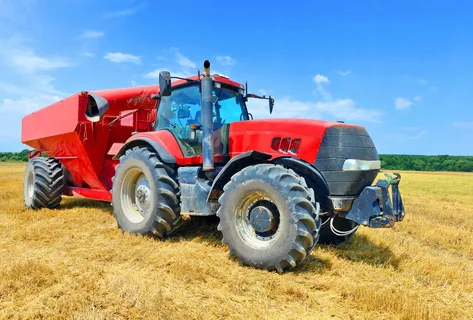The right spare parts can make all the difference when your tractor breaks down. Knowing which items to keep on hand can help you save money, repair time, and downtime.
It’s important to perform regular maintenance on your tractor equipment. This prevents the need for costly repairs down the road.
- Alternator
A properly functioning alternator provides your vehicle with the electrical current to run its lights, radio, and other accessories. Often called a generator in some vehicles, the alternator is comprised of multiple parts that can vary depending on your model. However, there are some general components to look out for.
Unlike a car battery, which stores a fixed amount of electricity, the alternator creates alternating current (AC) using electromagnetism between the rotor and stator. As the rotor spins in the housing, it generates electrical charges channeled back into the battery or used to power your other accessories.
If your alternator isn’t working correctly, you may notice the battery warning light on your dashboard flickering on and off. Additionally, your car’s headlights or dash lights may dim at low speeds or only work when the engine is turned on. A whining or buzzing noise is another common symptom of alternator problems.
The drive belt that turns the alternator’s pulley can become misaligned, which causes the pulley to rub against its bearings and create a loud whining sound. You might also smell a burning rubber odor from a bad alternator bearing.
Regularly greasing your tractor and keeping spare parts on hand are the best ways to avoid expensive repairs down the road. Adding a few items to your inventory, like a new wing knob, Zerk grease fittings, and replacement brushes, is a great way to keep your lawn tractors operating smoothly.
- Belts
Tractors work hard and are subject to wear and tear, which can slow them down or cause them to stop altogether. Whether in the middle of a field operation or at home during routine maintenance, it can be frustrating when you are dealing with a broken tractor. Keeping spare parts handy helps keep repair time and downtime to a minimum.
One of the most common repairs on tractors is replacing belts. These can loosen, crack, or split over time, which makes having a good supply of these parts on hand important. This can help to avoid a long period of downtime due to the fact that it may be difficult to find belts for your particular model in local tractor parts stores.
Another essential part to keep in stock is the gas filter, which can become dirty or clogged with debris from a variety of sources. This will also reduce the engine’s fuel efficiency and can lead to serious problems with the equipment. Another important type of filter is the hydraulic one, known to have issues that can render the entire machine unusable until it is replaced.
Finally, seatbelts can be easily forgotten, but they are important for everyone’s safety. It is recommended to keep a good supply of these replacements on hand in the event that they need to be replaced, especially when working with children or older people who may need extra security. Purchasing seat belts from a trusted seller, such as SeatbeltPlanet, will ensure you have a quality and compatible model for your tractor. Keeping these parts on hand will save you a lot of frustration and money in the long run.
- Grease
Grease is essential to the lubrication of all moving parts in your tractor and other equipment. It is important to have the correct grease in your inventory for the specific conditions of each piece of equipment and the mechanical environment. For example, a very thick lubricant won’t hold up under heavy loads where the moving parts are slow or infrequently moved, and a very thin lubricant won’t hold up to extreme pressures.
The best way to select a grease for a particular application is to consult the product data-sheet and rely on test results instead of marketing lingo. Several tests objectively examine a grease’s performance, including shear stability (how well it maintains consistency under shear or repeated quick applications) and water resistance.
A grease’s performance also depends on the oil used to make it and additives that control oxidation and protect against wear and other problems. Oil and additives compose 80 – 90% of the grease composition, with thickeners making up the remaining 20%.
There are many different types of grease on the market, all designed to meet various needs in a wide range of environments. The owner’s manual will often suggest a specific grease with specific specifications, but there is no reason why you can’t use a different brand as long as the new grease meets the original manufacturer’s recommendations. However, keeping multiple greases in inventory can create confusion, require the purchase of additional grease guns, and increase your overall costs. Having the right grease for your equipment and the proper tools to use it correctly is key to minimizing expensive repairs. Also, keep spare Zerk fittings on hand; they are easy to lose, and having extras will minimize downtime from lost grease fittings.
- Hydraulic Pump
It takes more than just gas and oil to keep your tractor running. Checking and topping off engine coolant, hydraulic fluid, radiator fluid, transmission fluid, and a variety of other fluids should be part of your daily preventative maintenance routine to avoid much bigger repairs down the road.
A common tractor component that needs regular replacement is the hydraulic pump. There are several types of hydraulic pumps on the market, but the most common are axial and radial piston pumps. Axial piston pumps use a series of pistons that reciprocate within internal cylinders to create alternating suction and discharge flows. A swash plate is often used to control the speed and pressure of these flows.
Radial piston pumps arrange a series of pistons radially around a rotor hub, with inlets and outlets on the periphery of the pump housing. The rotor, mounted eccentrically in the housing, rotates and forces the pistons in and out of their respective cylinders to produce flow. These designs also incorporate a pressure compensator piston to ensure constant discharge pressure under changing loads.
Both axial and radial pumps are generally more durable than gear pumps, as the gears mesh and un-mesh much less frequently, and the teeth have a more precise and higher-quality profile. This helps reduce noise and friction that can lead to mechanical failure in the form of a seizure or severe wear.
Whether your John Deere is a workhorse or a lawn mower, these small fixes can be the difference between an efficient day and a frustrating breakdown. Having spares of these parts on hand means you can be back up and running in a matter of seconds rather than hours, and it will save you from the potential loss of your crop or even the entire harvest.
- PTO
The PTO, also known as a power take-off, takes power from the tractor engine and transmits it to an attached implement. A PTO consists of a splined shaft and yoke at the tractor and a splined implement end with mating fittings that allow attachment to any implement that fits the same type of fittings on the yoke.
When used correctly, the independent PTO is a great tool to use for your farm operation. It has been around for a long time since the International Harvester Company first added it to some production models of tractors in 1918. Earlier versions of the PTO connected the tractor transmission to the implement, but this exposed the transmission to more damage and was unsafe for high-momentum implements. Modern PTOs are designed to transfer power safely and with minimal risk to the tractor’s transmission.
Unfortunately, it is common for the PTO to experience issues that can be very frustrating for farmers. A common problem is when the PTO disengages properly, leading to dangerous driving and equipment damage. This can be caused by a variety of things, such as warped discs or an improperly set brake.
Fleet managers should always be on the lookout for common problems with their tractors so that they can fix them before they cause any major damage or downtime. A good place to start is by performing an inspection of the tractor every day, just like you would do with any other vehicle in your fleet. A quick inspection will reveal any potential problems and can help prevent expensive repairs down the road. Having the most common tractor replacement parts on hand will also ensure that repair and downtime are kept to a minimum.




